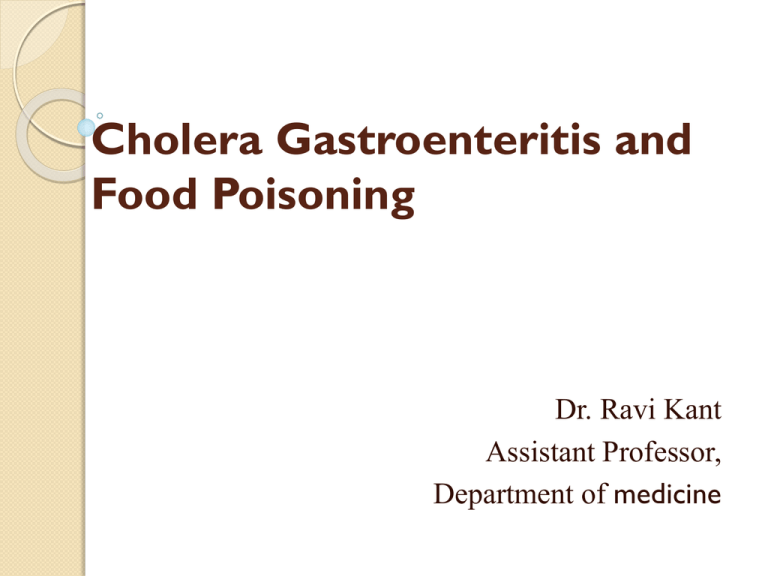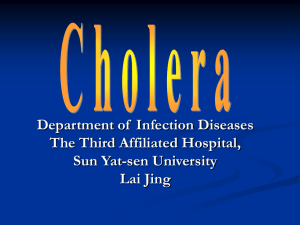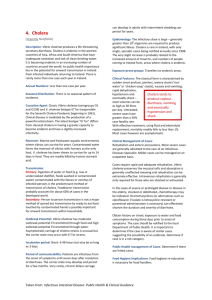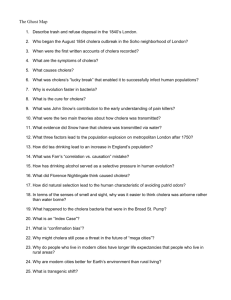Cholera - Dr. Ravi Kant
advertisement

Cholera Gastroenteritis and Food Poisoning Dr. Ravi Kant Assistant Professor, Department of medicine Definition Cholera is an acute diarrheal disease that can, in a matter of hours, result in profound, rapidly progressive dehydration and death. The term cholera has occasionally been applied to any severely dehydrating secretory diarrheal illness, whether infectious in etiology or not, it now refers to disease caused by V. cholerae serogroup O1 or O139—i.e., the serogroups with epidemic potential. The natural habitat of V. cholerae is coastal salt water and brackish estuaries, where the organism lives in close relation to plankton. Humans become infected incidentally but, once infected, can act as vehicles for spread. Ingestion of water contaminated by human feces is the most common means of acquisition of V. cholerae. There is no known animal reservoir. Pathogenesis Cholera is a toxin-mediated disease. The watery diarrhea characteristic of cholera is due to the action of cholera toxin, a potent protein enterotoxin elaborated by the organism in the small intestine. The toxin-coregulated pilus (TCP), so named because its synthesis is regulated in parallel with that of cholera toxin, is essential for V. cholerae to survive and multiply in (colonize) the small intestine. Cholera toxin, TCP, and several other virulence factors are coordinately regulated by ToxR. This protein modulates the expression of genes coding for virulence factors in response to environmental signals via a cascade of regulatory proteins. Additional regulatory processes, including bacterial responses to the density of the bacterial population (in a phenomenon known as quorum sensing), control the virulence of V. cholerae. Clinical Manifestations In a nonimmune individual, after a 24- to 48-h incubation period, cholera characteristically begins with the sudden onset of painless watery diarrhea that may quickly become voluminous. Patients often vomit. In severe cases, volume loss can exceed 250 mL/kg in the first 24 h. If fluids and electrolytes are not replaced, hypovolemic shock and death may ensue. Fever is usually absent. Muscle cramps due to electrolyte disturbances are common. The stool has a characteristic appearance: a nonbilious, gray, slightly cloudy fluid with flecks of mucus, no blood, and a somewhat fishy, inoffensive odor. Rice water cholera stool It has been called "rice-water" stool because of its resemblance to the water in which rice has been washed. Clinical symptoms parallel volume contraction: At losses of <5% of normal body weight, thirst develops; at 5–10%, postural hypotension, weakness, tachycardia, and decreased skin turgor are documented; and at >10%, oliguria, weak or absent pulses, sunken eyes (and, in infants, sunken fontanelles), wrinkled ("washerwoman") skin, somnolence, and coma are characteristic. Complications derive exclusively from the effects of volume and electrolyte depletion and include renal failure due to acute tubular necrosis. Thus, if the patient is adequately treated with fluid and electrolytes, complications are averted and the process is self-limited, resolving in a few days. Elevated levels of blood urea nitrogen and creatinine consistent with prerenal azotemia; normal sodium, potassium, and chloride levels. A markedly reduced bicarbonate level (<15 mmol/L); and an elevated anion gap (due to increases in serum lactate, protein, and phosphate). Arterial pH is usually low (7.2). Diagnosis The clinical suspicion of cholera can be confirmed by the identification of V. cholerae in stool. It can be detected directly by dark-field microscopy on a wet mount of fresh stool, and its serotype can be discerned by immobilization with specific antiserum. Laboratory isolation of the organism requires the use of a selective medium such as taurocholatetellurite-gelatin (TTG) agar or thiosulfate– citrate–bile salts–sucrose (TCBS) agar. If a delay in sample processing is expected, Carey-Blair transport medium and/or alkalinepeptone water-enrichment medium may be used as well. Standard microbiologic biochemical testing for Enterobacteriaceae will suffice for identification of V. cholerae. All vibrios are oxidase-positive. Treatment: Cholera Death from cholera is due to hypovolemic shock. In light of the level of dehydration and the patient's age and weight, euvolemia should first be rapidly restored, and adequate hydration should then be maintained to replace ongoing fluid losses. Administration of oral rehydration solution (ORS) takes advantage of the hexose-Na+ cotransport mechanism to move Na+ across the gut mucosa together with an actively transported molecule such as glucose (or galactose). This transport mechanism remains intact even when cholera toxin is active. ORS may be made by adding safe water to prepackaged sachets containing salts and sugar or by adding 0.5 teaspoon of table salt (NaCl; 3.5 g) and 4 tablespoons of table sugar (glucose; 40 g) to 1 L of safe water. The WHO now recommends "low-osmolarity" ORS for treatment of individuals with dehydrating diarrhea of any cause. Rice-based ORS is considered superior to standard ORS in the treatment of cholera. ORS can be administered via a nasogastric tube to individuals who cannot ingest fluid. Because profound acidosis (pH < 7.2) is common in this group, Ringer's lactate is the best choice among commercial products. Assessing the Degree of Dehydration in Patients with Cholera Degree of Dehydration Clinical Findings None or mild, but diarrhea Thirst in some cases; <5% loss of total body weight Moderate Thirst, postural hypotension, weakness, tachycardia, decreased skin turgor, dry mouth/tongue, no tears; 5–10% loss of total body weight Severe Unconsciousness, lethargy, or "floppiness"; weak or absent pulse; inability to drink; sunken eyes (and, in infants, sunken fontanelles); >10% loss of total body weight Degree of Dehydration, Patient's Age (Weight) None or Mild, but Diarrhea Treatment <2 years 1/4–1/2 cup (50–100 mL) of ORS, to a maximum of 0.5 L/d 2–9 years 1/2–1 cup (100–200 mL) of ORS, to a maximum of 1 L/d 10 years As much ORS as desired, to a maximum of 2 L/d Moderate <4 months (<5 kg) 200–400 mL of ORS 4–11 months (5–<8 kg) 400–600 mL of ORS 12–23 months (8–<11 kg) 600–800 mL of ORS 2–4 years (11–<16 kg) 800–1200 mL of ORS 5–14 years (16–<30 kg) 1200–2200 mL of ORS 15 years (30 kg) 2200–4000 mL of ORS Composition of World Health Organization Reduced-Osmolarity Oral Rehydration Solution (ORS) Constituent Concentration, mmol/L Na+ 75 K+ 20 Cl– 65 Citrate 10 Glucose 75 Total osmolarity 245 Electrolyte Composition of Cholera Stool and of Intravenous Rehydration Solution Concentration, mmol/L Substance Na+ K+ Cl– Base Adult 135 15 100 45 Child 100 25 90 30 Ringer's lactate 130 4a 109 28 Stool Prevention Provisionof safe water and facilities for sanitary disposal of feces, improved nutrition, and attention to food preparation and storage in the household can significantly reduce the incidence of cholera. Much effort has been devoted to the development of an effective cholera vaccine over the past few decades, with a particular focus on oral vaccine strains. Traditional killed cholera vaccine given intramuscularly provides little protection to nonimmune subjects and predictably causes adverse effects, including pain at the injection site, malaise, and fever. The vaccine's limited efficacy is due, at least in part, to its failure to induce a local immune response at the intestinal mucosal surface. Two types of oral cholera vaccines have been developed. The first is a killed whole-cell (WC) vaccine. Two formulations of the killed WC vaccine have been prepared: one that also contains the nontoxic B subunit of cholera toxin (WC/BS) and one composed solely of killed bacteria. Protective efficacy rates for both vaccines declined to 50% by 3 years after vaccine administration. Gastrointestinal Pathogens Causing Acute Diarrhea Mechanism Location Illness Noninflammatory Proximal small Watery (enterotoxin) bowel diarrhea Stool Findings Examples of Pathogens Involved No fecal leukocytes; mild or no increase in fecal lactoferrin Vibrio cholerae, enterotoxigenic Escherichia coli (LT and/or ST), Inflammatory (invasion or cytotoxin) Colon or distal Dysentery or Fecal Shigella spp., small bowel inflammatory polymorphonuclear Salmonella spp., diarrhea leukocytes; substantial increase in fecal lactoferrin Penetrating Distal small bowel Enteric fever Fecal mononuclear Salmonella typhi,Y. leukocytes enterocolitica Approach to the Patient: Infectious Diarrhea or Bacterial Food Poisoning Physical Examination The examination of patients for signs of dehydration provides essential information about the severity of the diarrheal illness and the need for rapid therapy. Mild dehydration is indicated by thirst, dry mouth, decreased axillary sweat, decreased urine output, and slight weight loss. Signs of moderate dehydration include an orthostatic fall in blood pressure, skin tenting, and sunken eyes (or, in infants, a sunken fontanelle). Signs of severe dehydration include lethargy, obtundation, feeble pulse, hypotension, and frank shock. Post-Diarrhea Complications of Acute Infectious Diarrheal Illness Complication Comments Chronic diarrhea Occurs in 1% of travelers with acute Lactase deficiency diarrhea Small-bowel bacterial overgrowth Protozoa account for 1/3 of cases Malabsorption syndromes (tropical and celiac sprue) Initial presentation or exacerbation of May be precipitated by traveler's diarrhea inflammatory bowel disease Irritable bowel syndrome Occurs in 10% of travelers with traveler's diarrhea Reactive arthritis (formerly known as Particularly likely after infection with Reiter's syndrome) invasive organisms (Shigella, Salmonella, Campylobacter, Yersinia) Hemolytic-uremic syndrome (hemolytic Follows infection with Shiga toxin– anemia, thrombocytopenia, and renal producing bacteria (Shigella dysenteriae failure) type 1 and enterohemorrhagic Escherichia coli) Guillain-Barré syndrome Particularly likely after Campylobacter infection Bacterial Food Poisoning Incubation Period, Organism 1–6 h Staphylococcus aureus 8–16 h Clostridium perfringens Symptoms Common Food Sources Nausea, vomiting, diarrhea Ham, poultry, potato or egg salad, mayonnaise, cream pastries Abdominal cramps, diarrhea Beef, poultry, legumes, (vomiting rare) gravies >16 h Vibrio cholerae Enterohemorrhagic E. coli Watery diarrhea Bloody diarrhea Salmonella spp. Inflammatory diarrhea Shigella spp. Dysentery Vibrio parahaemolyticus Dysentery Shellfish, water Ground beef, roast beef, salami, raw milk, raw vegetables, apple juice Beef, poultry, eggs, dairy products Potato or egg salad, lettuce, raw vegetables Mollusks, crustaceans The End




